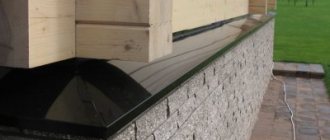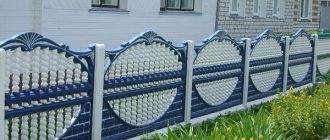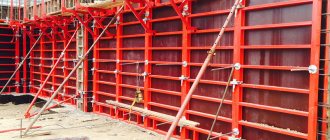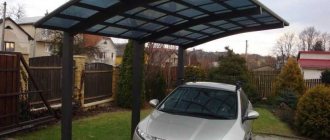When setting up a country house, the first thing that is done is the sewerage system.
The wastewater is discharged into a special container. Manufacturers offer a huge selection of these designs, but not everyone can afford to buy expensive equipment. A do-it-yourself overflow septic tank is a worthy alternative to a purchased storage tank.
A septic tank can be built from concrete or plastic rings, made from monolithic concrete, used in plastic barrels, or made of brick.
A septic tank with overflow is a storage tank for wastewater treatment consisting of two or more sections. Important! The more chambers, the higher the degree of water purification.
Septic tank diagram
The standards stipulate the minimum permissible distances from the treatment plant to various objects, in particular to the house:
- settling tanks: 5 m;
- drainage well: 8 m;
- filtration field: 15 m.
It is recommended to build sedimentation tanks at a minimum distance from the house: due to the slope of the pipe leading to them, if the chambers are located far away, the chambers will have to be deeply buried. The chambers of the structure are located nearby, but not closely, otherwise damage may occur due to ground movements.
Usually a gap of 0.5 m is left, filled with soil. The drainage well, and even more so the filtration field, is located at a certain distance in order to minimize the effect of frost heaving forces on the settling tank, caused by the abundant moisture content in the soil (discharged wastewater).
The entrance of the overflow pipe between the 1st and 2nd chambers is located just below the pipe laid from the house. Enough for 5 cm. The diameter of the overflow pipe is 110 mm, the slope is 20 cm/m. The next overflow pipe is also located slightly lower. Sometimes, in order to ensure sufficient volume under the outgoing overflow pipe, the 2nd chamber is dug in below the 1st, and the 3rd - below the 2nd.
Scheme of a concrete septic tank made of 2 wells
The top of the chamber is covered with a reinforced concrete slab - purchased or cast on site. The slab must have openings for hatches (through which pumping is carried out) and ventilation pipes.
The three chambers of the septic tank do not have to be lined up. Placing them at the vertices of an isosceles triangle will reduce the volume of excavation work and make it possible to get by with one inspection hatch for access to overflow pipes.
Cesspool with overflow: design features, operating principles and diagrams
The problem of waste disposal in a private suburban area has long been solved with the help of an ordinary cesspool, which is a storage tank. The structure has to be constantly pumped out and there is no escape from the unpleasant smell. To solve the problem, it is better to use a more modern independent treatment facility - a cesspool with an overflow. The design is capable of processing large amounts of liquid waste. These are wastewater from shower stalls, dishwashers, washing machines, bathtubs, and appliances used to improve comfort. Therefore, it is necessary to consider the device, operating principle and possible options for an improved sump. This will allow you to avoid the issue of constructing a treatment plant on private territory that is not connected to a centralized sewerage system.
Multi-chamber overflow septic tank with biofilter
- A pit with an area of three rings is dug out. The height depends on the number of rings. The pit is dug so that the cameras go one after another from the house.
- A trench is created under the sewer pipe, with a slope from the house to the septic tank.
- The bottom of the pit is covered with a layer of sand and crushed stone. Levels out.
- The bottom of the first well is installed. If there is no bottom, we make a screed.
- The first well is being assembled.
- The remaining two tanks are installed using the same scheme.
- The walls of the chambers fit tightly to each other.
- Connecting seams are treated with mortar and bitumen mastic.
- Openings are created for the sewer and overflow pipes, as well as from the last chamber, for the outlet pipe.
- The pipes are being connected.
- A biofilter is installed in the second chamber. Store bought
- DIY
It is worth noting that biofilters can be either volatile or non-volatile.
- If the biofilter has a compressor, then it is better to lay the cable for it together with the sewer pipe. To bury the cable, a special corrugated pipe of small diameter is used.
- The biofilter can be attached on cables to the tank lid or installed on the bottom.
- The compressor for the volatile filter is mounted in a separate niche or mounted on the lid.
- The inlet and overflow pipes are connected.
- The septic tank is filled with soil.
- A pipe is connected to the branch pipe from the last chamber, which goes into the infiltrator or filtration field.
Features of the design of a two-chamber sewage pit
The cesspool design with two compartments is used in small and medium-sized areas. Construction of the structure begins with marking the territory. At this stage, the configuration of the pits is determined. However, in some cases it is advisable to create one large pit. After installing tanks in it, the space between the tanks is filled with soil.
In the receiving chamber, the bottom is filled with concrete mortar. To make the screed as strong as possible, crushed stone is added to it. The walls of the compartment are constructed directly on the created foundation. If concrete rings are used during the construction of a structure, then the solution is poured inside the structures. It is recommended to coat the sealed container with waterproofing material on the inside.
Concrete rings can be dug into the ground without the use of construction equipment. To do this, a reinforced concrete structure is first installed on the ground surface. Then the soil is removed in an area whose boundaries are the inner space of the ring. Then it is necessary to gradually undermine the soil under the walls of the structure. As a result, the reinforced concrete ring will be lowered into the shaft being created. This method is especially relevant if there is light soil on the site, as it does not allow the walls of the pit to crumble. When using other materials to create a treatment plant, you need to dig a hole with inclined walls. A slight slope will prevent them from collapsing.
When using a plastic tank as a reservoir, it is necessary to fill it gradually while simultaneously filling it with water. This will prevent deformation of the container, which may occur due to soil pressure.
The second chamber is equipped with a waterproof bottom. Then the pipes are laid below the freezing point of the soil. For additional protection of pipelines from freezing, you can use any of the popular heat insulators. It is recommended to install vertical sections at the ends of the overflow pipe. This will allow the treatment plant to function better because it will be impossible for wastewater to flow in the opposite direction if the tanks overflow. When an overflow well is equipped with additional drainage, a pipe is used that is laid in the ground on a bed of crushed stone.
Methane gases are removed from sewage depending on the type of bacteria involved in the operation of the treatment plant. Some microorganisms are always found in wastewater. However, the process of processing sewage can be accelerated if more anaerobic or aerobic bacteria are added to a sealed tank. The first type of microorganisms can live without oxygen, unlike the second type of bacteria. Therefore, it is better to use anaerobic microscopic organisms in a sealed tank.
When a ventilation device is finally installed, then a hole is created in the cover of the treatment plant for a pipe whose diameter is approximately 100 mm. This ventilation duct is closed from above with a conical cap. This will prevent sediment and debris from entering the cesspool.
What is the difference between a septic tank without pumping?
What are the characteristic features of such a system? The answer lies in the operating principles. Wastewater undergoes a process of separation into liquid, which can subsequently be discharged into drainage, and solid components. It is solid waste that will eventually require pumping, but due to the fact that its volume will be much smaller, pumping can be carried out less often “no more than 6-9 years.” For subsequent disposal, waste coming from the sewer system of a country house requires separation - division into heterogeneous fractions. The use of special impurities in the process, which include enzymes, provides a significant increase in the service life of such a system, because thanks to the activity of organisms, aerobic and anaerobic bacteria, the sludge existing in the system is well processed into methane and carbon dioxide, which are discharged using a ventilation pipe mounted above the storage tank. According to the peculiarities of its design, a septic tank for a dacha without pumping is nothing more than a two-chamber waste disposal system, in other words, a two-chamber septic tank. The meaning of dividing one container into two chambers is as follows:
- sealed chamber - here the contaminated water entering the septic tank is received and settled without pumping directly from the house sewer system. Solid compounds settle and oily compounds rise to the surface. Due to this, the wastewater is partially purified and prepared for the next stage of treatment.
- second chamber - wastewater that has already undergone primary treatment enters here. Further disposal takes place naturally - the chamber has no bottom, therefore the liquid seeps into the soil through a special layer of gravel or crushed stone.
The huge demand for a septic tank for a dacha without pumping has led to the appearance on the market of a system with smaller dimensions, the so-called mini-septic tank. Such septic tanks for a dacha without pumping are budget versions of the usual ones that will allow installation of the system in fairly dense buildings, or in cases where the available area of the site is limited.
Septic tanks for summer cottages without pumping, budget treatment systems. A system with three chambers is not used so often, despite its greater efficiency, because the cost of such a system cannot be compared with a two-chamber septic tank. If the owner is concerned about the environmental side of the issue, then a treatment station will be the best solution. Such a station provides the highest possible level of purification; the water after treatment is suitable for watering and washing a car, and organic residues in the form of sludge are suitable as fertilizers. But there is also a significant disadvantage - such a system is energy dependent and requires expenses to maintain its functionality.
Design advantages and disadvantages
The question of why an overflow septic tank is created can be answered with a list of the advantages that this design has. These include:
- safety for ecology, environment;
- high level of wastewater treatment;
- stability of operation during salvo discharges;
- the ability to record the territory in a convenient place (taking into account sanitary standards);
- no dependence on electricity;
- possibility of self-installation;
- low cost.
Among the disadvantages of such structures are the need for periodic cleaning of containers (especially the first one), as well as the appearance and spread of stench if operation is disrupted.
Choosing a septic tank depending on the type of soil
Septic tank on clay soil
A septic tank installed on clay soil is fundamentally different from others. The problem is that the relatively “clean” water that comes out of the settling tanks must undergo soil purification. But here it is impossible.
For reference! During the day 1 sq. a meter of sand absorbs about 90 liters of water, sandy loam soil about 50 liters, loam - 25 liters, and clay absorbs no more than 5 liters of water per day per the same square meter of surface.
Installation of a septic tank
There may be several ways out of the situation.
- Deep filtration well. As a rule, the clay layer does not exceed 2-3 meters, and under it there is already a layer of sandy loam or sand with excellent absorbency.
- Watering. Instead of filtering wells or fields, an ordinary sealed container is buried in the ground, and the runoff accumulated in it is used for irrigation. Such a septic tank is suitable for a summer residence with seasonal residence.
- Filtering field. If the soil is characterized by at least some absorption capacity, then the area of the filtration field is increased to the required size, which will be able to absorb the daily volume of water.
Septic tank on soil with a high groundwater level
The problem of installing a septic tank on soil with a high groundwater level is primarily associated with the difficulty of building anything at all. In addition, it is impossible to organize soil drainage on wet soil. But you can use one of the following options.
Septic tank for above-ground installation
Above ground installation. In this case, the septic tank container is placed on the surface. Installing the tank is much easier, and the obvious disadvantages will be the unaesthetic appearance of the site, minus the usable area and the cost of sewer cleaning, since the filtered liquid will not be able to be absorbed into the soil. In some cases, it may be necessary to install a sewage pump to supply wastewater to the septic tank.
Septic tank for installation in soil with high groundwater levelsA system designed for installation on soil with a high groundwater level. There are septic tank models that operate fully at high groundwater levels. Their location is underground, and installation of the installation is quite complicated. In addition, they cost an order of magnitude more than conventional models. Additional wastewater treatment is carried out through a bulk filtration field or special filter cassettes are installed.
Septic tank on sandy soils
In sandy soils, in principle, any septic tanks can be installed, including those made of reinforced concrete rings. In waterproof soils, their installation is undesirable, since concrete is not completely sealed and such a septic tank quickly fills up during a flood.
Scheme: septic tank made of concrete rings
The best option for post-treatment of wastewater on sandy soils would be filter fields or wells. It is possible to use biological treatment.
General information
Kinds
A storage device with several compartments can be of three types
- Two sections, where the second is a drainage well. Not all wastewater is allowed into such a septic tank. And it is not recommended to install it for a home with a large family. A good option for a summer house or a small house where 1-2 people live permanently.
- Two chambers and a post-treatment system. This design can be assembled for almost any home. But the number of permanent residents should not exceed 8 people.
- Septic tanks of 2-3 chambers with a post-treatment system, working with a biofilter. If you want to preserve the environment, save on sewerage systems and practically forget about the storage tank, then this option is ideal.
In order to build a septic tank, you need to choose a location.
Installation norms and rules
According to SNiP there is an acceptable minimum distance to certain objects
- 5 m to a residential building
- 3m. to the trees
- 10m. to a river or stream
- 30m. to a well or borehole
- 50m. to a lake or any other large body of water
- 5m. to the road
Volume calculation
After the installation location has been determined, the volume of the septic tank should be determined. According to SNiP statistics, one person uses 200 liters of water per day. There is a difference between the volume of a conventional septic tank and a septic tank with a biofilter. For a conventional drive, the calculation formula is as follows:
200l. * for the number of residents + 1/3 of the resulting volume.
Example.
200*5=1000l 1000/3=330l
1000+330=1330l
It is better to round the number up. For a family of 5 people you will need a septic tank with a volume of 1400 liters. If the sewer storage tank has a biofilter, then the volume should be increased not by 1/3, but at least 2 times.
The fact is that bacteria take a certain time to work. According to SNiP, water must be treated in this way for 14 days. Multiplying 1000l (5 people) by 14 is at least not reasonable. The result will be a septic tank that is too large, and there will be no water consumption in such an amount.
Making a septic tank of 2500 - 3000 liters is more than enough.
After calculating the volume and choosing the installation location, you can begin installation.
Storage septic tank
The storage option is not much different from a cesspool. It is a large container, into which the wastewater is divided into light and heavy fractions. The light ones, of course, remain on the surface, and the heavy ones sink to the bottom.
Considering that the waste from such a “barrel” has nowhere to go, it is better to make it in a very large volume. To do this, you will have to use many rings and either make the reservoir very deep (you need to take into account the location of the groundwater) or make several, applying the law of communicating vessels (as an option for clay soil, but they will need to be pumped out each separately). This will be needed in order to pay for the services of vacuum cleaners less often.
Such a septic tank looks quite simple: the bottom must be concreted, and rings are installed on the bottom - one on top of the other. A plate with a hole for the hatch is placed on top of the rings, and the hatch itself is installed on it. All joints must be sealed, as well as the entire container.
Once the container is full, all contents must be pumped out.
Regulatory rules for the construction of a wastewater treatment plant with overflow
The construction of a sump with an overflow well begins with choosing a location for the structure. It is necessary to ensure that special equipment, including a sewer truck, can approach it. The selection of the location is carried out taking into account the distance of the future structure from other objects, since it is necessary to take all measures to prevent contamination of groundwater. The type of soil in the area is also taken into account. If it has high permeability, then the distance to objects increases.
Varieties
When organizing an autonomous sewer system, several pit options are used:
- Absorbent with a filter at the bottom. The design is an underground reservoir, in the lower part of which there is a filter made of sand, soil and crushed stone. Incoming wastewater seeps through the filter layer and goes into the deeper layers of the soil. Used for small volumes of daily discharges.
A single-chamber septic tank is simpler and cheaper, but requires more frequent cleaning than a 2-chamber septic tank Source eco-well.rf
- Closed storage chambers. Systems include one or more sealed tanks connected in series. With the simplest device, the wastewater is pumped out after filling, and with a more advanced one, it is additionally decomposed under the influence of bioactive preparations.
- Overflow. Includes two tanks - settling and filtration. In the first, the primary sewer discharge occurs. Then, as it settles, the water is poured into the second, from which it enters the ground through a filter in the lower part or for technical needs.
It is generally accepted that in order to properly make a septic tank with an overflow, it is necessary to use concrete rings. This is just one of the most affordable, reliable and fastest ways to install a sewer system. In fact, the following additional options exist:
- Plastic or metal containers of suitable dimensions. The lowest budget method for arranging both a storage and filtration tank.
- Factory made plastic wells. New durable designs with a long service life. However, they will be quite expensive.
Exploitation
After successfully resolving the issue of how to connect a private house to the central network, many take a breath and for some reason believe that now everything will work like clockwork. However, such sewerage still needs to be monitored. To ensure that its service life does not decrease, you need to follow simple rules, the main ones of which are:
- Try to prevent large-sized and durable debris from entering the drain, for example, solid kitchen waste, personal hygiene items, hair, paper, etc.
- Clean kitchen siphons regularly.
- Use a plunger to clean the toilet.
Video on the topic:
The principle of operation of the design
The operating principle of a three-chamber septic tank.
Treatment facilities of this type are capable of filtering sewage up to 90–95%. The design of an overflow two-chamber septic tank is quite simple. The two tanks are connected to each other using plastic pipes.
There may be more containers, but a couple are enough for a small cottage. The first acts as a settling tank and reservoir for water-insoluble heavy dirt particles. It must have a hatch for the hose of the sewage disposal equipment, since such septic tanks still require pumping, although less often than just storage tanks.
Once in the second chamber, the clarified liquid is repeatedly settled and purified by bacterial flora, which feeds on organic matter and biowaste.
After cleaning in the second container, the liquid is sent to the filtration fields or to the infiltrator. It is also possible to install filter screens and grease traps in the overflow tube, which retain some of the dirt when the wastewater is overflowed from one container to another. Filtration devices contain bacteria that help decompose waste. When using an aerobic type of microorganisms, the structure is equipped with ventilation shafts or an aerator.
Where does the sewer flow? Interesting facts
Inquisitive minds often ask questions that not every average person would think of. For example, where does the sewer flow? But this is really extremely interesting.
There are all sorts of rumors about this. Someone says that all the city sewerage flows directly into the river, so swimming on city beaches is not recommended.
Others claim that liquid waste goes underground through special drains and is absorbed into the depths of the soil.
note
However, if you just imagine how many millions of cubic meters the residents of Moscow allocate every day, there won’t be enough soil to “suck” it into itself.
We have prepared for you interesting facts and photographs about what happens to the sewer after it leaves our home.
Where does the sewer go?
It’s unlikely that anyone wonders where the waste that we flush down the sewer pipes goes to. And they have a long journey ahead of them.
First of all, it must be said that enterprises use their own individual cleaning system. That is, waste from large factories is not connected to the citywide sewerage system.
Everything is clear here. What about the city sewerage? We decided to take Moscow as an example of interesting facts about cities.
Nowadays, one can often hear outrage that the Moscow River will soon turn into a swamp due to the fact that millions of tons of sewage waste from the city and even enterprises flow into it almost directly.
In reality, everything is not so simple. If this were true, then the Moscow River would have long ago become a real septic tank, and everyone who swims there would be infected with various diseases.
It must immediately be emphasized that waste from human everyday life in liquid form flows into special treatment facilities that exist in every city. This is the key point.
What happens to the sewer in the end?
In a nutshell it can be described as follows. When liquid waste from city sewers flows into wastewater treatment plants, it undergoes a primary stage of treatment, which results in the precipitation of sludge.
You will be surprised, but this is a really interesting fact: from this sludge they then make... gas.
Schematically, the sewage waste treatment process is as follows:
So, at the very beginning, sewage enters the treatment system through giant pipes. Traffic is approximately 2.5 million cubic meters per day:
Important
Next, the first stage of cleaning is filtration with special gratings of waste larger than 10 mm:
Now the water enters the first settling tank, where it remains for exactly two hours. During this time, the settled organic matter is sent for biogas production, and the rest goes further through the system:
This is the second sump:
In general, there is a constant analysis of water coming from the city’s drains, tap water and purified:
And only after such thorough purification does water enter the Moscow River directly from this reservoir:
Now you know where all the Moscow sewers flow and what happens to wastewater and other sewage. All cities in the world operate on approximately the same cleaning principle.
Otherwise, the very existence of megacities would be impossible.
By the way, read interesting facts about Russia - you will learn many amazing things. We also recommend subscribing to InterestnyeFakty.org. It's always interesting with us!
Did you like the post? Press any button:











